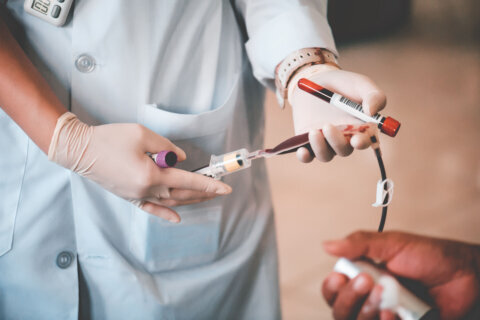Healthy eating is a goal for many people.
However, sometimes this avid interest crosses over into an eating disorder called orthorexia nervosa, which is an extreme obsession with healthy eating that often leads to malnutrition and impairs daily functioning.
First coined in 1997, the term orthorexia describes an unhealthy, highly restrictive diet based on nutritional quality rather than quantity like most diets. This condition can become a detriment to someone’s mental and physical well-being. Their ability to live and enjoy life is hindered by the limitations placed on them by their own strict dietary rules. These rules interfere more and more with other aspects of their life and their ability to go out and freely enjoy social situations, such as dinner with friends or a holiday party.
“Orthorexia affects mainly adults and more women than men, but there’s less of a gender difference with this condition compared to other eating disorders,” explains Dr. Tom Hildebrandt, a professor of psychiatry and chief of the Center of Excellence in Eating and Weight Disorders at Mount Sinai in New York City.
[READ: Tips for Eating Disorder Recovery.]
Is It Healthy Eating or Orthorexia?
Healthy eating is an admired lifestyle choice and one many aspire to. The willpower, discipline and level of planning needed to strictly maintain this can be a challenge, especially when prepackaged, processed foods are plentiful and often easier both on the wallet and the clock.
Flexibility plays an important role in being able to sustain a healthy lifestyle long term, but for those with orthorexia, that flexibility is nonexistent.
They cannot give themselves a “free pass” to indulge once in a while in a favorite ice cream or slice of pizza. They tend to overanalyze nutrition labels and have a rigid, inflexible relationship with food that is characterized by a restrictive diet and extreme avoidance of foods they deem unhealthy. The idea of eating these foods can give them severe anxiety and distress, as well as a decreased sense of self-worth.
The type of food restrictions depends on the individual and, typically, the list of unacceptable foods or ingredients usually grows over time. Examples of restrictions may include:
— Eating only raw or organic foods.
— Eliminating items made with sugar, additives, artificial colors or flavors.
— Avoiding foods that contain genetically modified ingredients, hormones or pesticides.
As time goes on and the list of banned food items lengthen, nutritional deficiencies become a concern as cutting out whole types of foods narrows someone’s ability to select foods rich in important nutrients.
“Many people end up adopting unsustainable and unhealthy practices in the quest of obtaining ideal or perfect or even just improved health,” says Dr. Kimberly Dennis, a psychiatrist and certified eating disorders specialist and a member of the clinical advisory council for the National Eating Disorder Association.
[READ: What is Atypical Anorexia?]
Orthorexia Risk Factors
In a 2019 paper published in the journal Appetite, researchers reviewed numerous studies to identify the most common risk factors for orthorexia. They reported that gender and self-esteem were not related to developing orthorexia, but they identified several other risk factors, including:
— Dieting.
— Drive for thinness.
— History of eating disorders.
— Obsessive-compulsive traits.
— Poor body image.
— Psychopathology.
Studies show that social media plays an influential role in developing orthorexia, as well as other disordered eating habits. In a 2022 randomized controlled study published in the International Journal of Eating Disorders, researchers evaluated the link between social media and eating disorder risk among 170 university students and found that exposure to appearance-related social posts were linked to poorer body image and disordered eating. Similarly, a 2022 study in BMC Pregnancy Childbirth showed that postpartum mothers not only experienced more body image dissatisfaction but also reported a greater desire to be fit and active and engaged in restrictive eating behaviors after seeing body-focused social media posts.
“Social media’s whole purpose is to influence, but I think that it influences people who are vulnerable and can take eating healthy to a whole new level,” Hildebrandt says.
[READ: Popular and Dangerous Social Media Diet Trends.]
Symptoms of Orthorexia
Recognizing the difference between the discipline needed to consistently make healthy eating choices and the rigid, inflexible eating choices of orthorexia can be difficult if you don’t know what to look for.
Some symptoms include:
— An over-the-top fixation with healthy foods, nutrition and eating.
— Acute fear of what is deemed unhealthy foods and rigorous avoidance of those foods.
— Extreme anxiety when faced with the possibility of deviating from their dietary regimen.
— Constantly checking ingredients and nutrition labels.
— High levels of distress and agitation when “safe” foods are not available.
— Progressively eliminating groups of food, like all carbs or all dairy.
— Excessive worry over foods served at social situations that results in evading social situations.
— Avoiding food prepared by others under the assumption the food will not meet the healthy standards they have set for themselves.
— Having an uncommon interest in the food choices of others.
— Avidly following certain foods, clean eating, or healthy lifestyle bloggers or influencers online.
Diagnosing Orthorexia
Currently, orthorexia is not included in the American Psychiatric Association’s Diagnostic and Statistical Manual of Mental Disorders (DSM-5), which sets the universal criteria used in diagnosing mental health disorders
. Because there’s no formal diagnostic criteria for orthorexia, clinicians use differing methods and tools to diagnose the condition in patients.
When diagnosing orthorexia, doctors look to determine someone’s views, emotions and actions regarding food and eating and evaluate how their eating behaviors negatively impact their daily life, relationships and health.
In addition, a person’s emotional dependence to follow dietary rules is also examined.
“Orthorexia has to do with the kind of rigidity in which you apply the rules or tenets of a diet and the degree that you believe harm will come to you if you deviate from it,” Hildebrandt says.
Orthorexia Treatment
According to the National Eating Disorder Association, there are no specific treatments developed for orthorexia. Many clinicians turn to therapies commonly used to treat anorexia and obsessive-compulsive disorder, including exposure therapy, cognitive behavioral therapy and enhanced cognitive behavioral therapy, which was developed specifically for eating disorders and focuses on addressing and modifying the different factors that maintain the behavior.
“When we treat orthorexia, we look to increase the degree of flexibility, not change the belief necessarily,” Hildebrandt says. “For example, if you are a vegan and you have a belief system that supports being a vegan what the treatment does is try to increase the flexibility around that.”
Ultimately, with proper diagnosis and treatment, clinicians can help people with orthorexia reestablish a healthy relationship with food.
“You can make decisions to eat food consistent with your beliefs and not experience the distress and guilt,” Hildebrandt adds.
More from U.S. News
Best Mediterranean Diet Food List
Delicious and Healthy Snacks for the Mediterranean Diet
Orthorexia: The Unhealthy Obsession with Healthy Eating and How to Break Free originally appeared on usnews.com
Update 03/21/23: This story was previously published at an earlier date and has been updated with new information.







